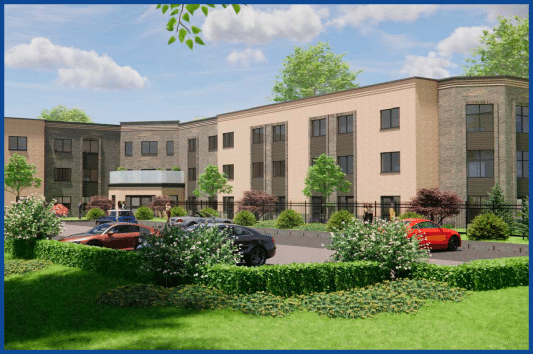

It was an absolute pleasure to be part of this proposal in Brockworth for a three-storey, 66-bed care home facility, along with associated ancillary works. Planning was approved in February of this year.
The site comprised a single dwelling in ample grounds, surrounded by playing fields and residential gardens with established border treatments.
Key planning considerations included:
Although outside the settlement boundary for Brockworth, the development site benefitted from being adjacent to a strategic allocation, outlined in the Gloucester, Cheltenham and Tewkesbury Joint Core Strategy 2011-2031. Furthermore, at the time of submission, the Council could not demonstrate a five-year housing land supply. The proposal would therefore help to address the identified need for registered care beds in the locality, and the quantum proposed would make a useful addition to the Council’s housing supply figures.
Regarding the increase in built form compared to the existing, whilst this undoubtedly represented a key planning issue, it was successfully evidenced that the scheme could be delivered without unacceptable wider landscape and visual impacts, particularly given the significant additional residential development taking place adjacent to the site. As a result, we successfully justified that the minor visual harm created by the new built form would be comprehensively outweighed by the substantial benefits that would result from the development.
Given this, a positive pre-application response was received, which acknowledged that the principle of development was acceptable, along with the proposed quantum of development which initially sought an 82-bed care home with associated amenity space, parking provision and a revised access point.
On this basis, working effectively across a multi-disciplinary project team, a full planning application was submitted. However, statutory consultee responses received during the determination period raised several concerns. We liaised effectively with the case officer and wider project team, presenting a series of solutions and mitigation measures to assuage concerns and present a scheme which responded positively to statutory responses and ensured a suitable quantum of care provision, adhering to the vision of our client.
These included:
The application was decided at Planning Committee, and we are delighted that following our involvement, all concerns raised by the statutory consultees were successfully resolved and that planning was approved in a timely manner.
We are McLoughlin Planning, and our team has a simple objective: to get results for our clients by providing high quality planning consultancy.
Our team of chartered town planning consultants deal with a host of interesting planning projects from across southern England and Wales – from strategic promotions and commercial premises to private developments and rural projects.
We are a friendly and approachable team who care passionately about the built environment, always striving to get the best outcome for our clients and the community.
If you have a development project which would benefit from expert planning consultancy input, then feel free to contact us through either our “Arrange a Call” tab on our contact page or via the email and telephone number provided below.
Joe Seymour – Associate Director
E: joe.seymour@mplanning.co.uk
T: 01242 895 121
Project team:
Image source: LNT Construction
We have a simple objective: to get results for our clients by providing high quality planning consultancy. That means our goal is to secure planning permission or an allocation for development.
We have used McLoughlin Planning (London) on two or three occasions and found them efficient, knowledgeable and excellent at negotiating with Local Authorities and third parties. Their concise and specific advice helped us win approval for schemes which had previously been notified for refusal. We would not hesitate using them again for planning issues in London.
Rob Haine Haine & Co. Ltd.Having worked with Nathan and his team for a number of years, I have found he offers a rare combination of intellectual rigour and practical focus, coupled with a commercial approach. He is solution orientated and capable of delivering on accelerated timelines for clients at the highest level with exacting standards and positive results.
Craig Jordan Jordan HennessyI have known Nathan for over 10 years and have used his services to great effect where professionalism, tenacity and a clear focus have been required, to deliver successful results. With a cool head, aligned with attention to detail and commercial acumen, he and his team work effectively and diligently and we look forward to engaging on other projects in the future
Grant Westall-Reece AvantWorking with McLoughlin Planning has been very enjoyable. I have always found the team knowledgeable and easy to work with. They have always been professional and have managed to achieve the results desired.
Matt Richardson Legal and General HomesWe have used Nathan and his team to help with a range of planning matters on a number of occasions. I have always found them to be extremely helpful, responsive and proactive. Nathan always makes himself available for phone calls and or meetings. He is especially patient and good at explaining complex matters in a very user friendly way.
Mark Lawson The Buying SolutionWe have worked with McLoughlin Planning for many years and have always been very pleased with level of service in helping us navigate the ever-changing planning system. I also never cease to be impressed by the answers to the completely random questions I ask Nathan about possible new sites, normally in several different locations at one go.
Ian Hitchings Partridge Homes (Cotswolds) LtdAfter many years of working with Nathan and his team, we know we can trust their planning opinion. They often provide a solution that demonstrates Planning experience and expertise and the benefit of their input is measured by the planning approval success and infrequent need to go to appeal on a decision.
George Paton WebbPatonWe have consistently used McLoughlin Planning to successfully promote greenfield development sites in a variety of locations. Aside from their technical capabilities, we also value their considered approach to projects - particularly when dealing with delicate and complex planning issues. This makes them a natural part of our team.
Alistair Watson Welbeck Strategic LandIf you are interested in finding out how we can help you please get in touch
Notifications